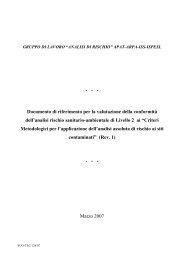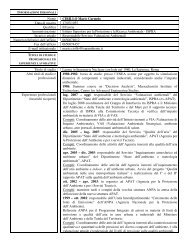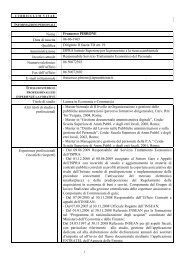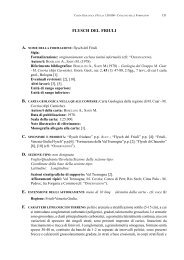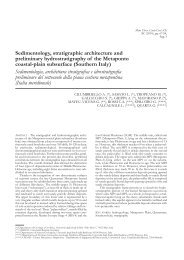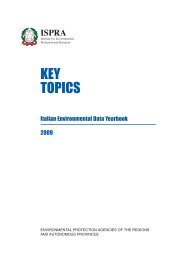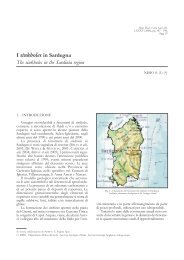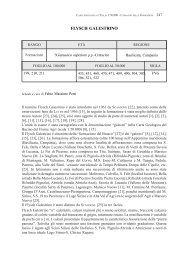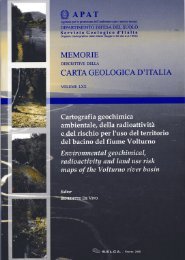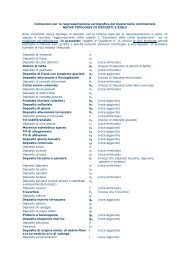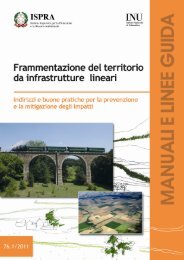Guidebook - Ispra
Guidebook - Ispra
Guidebook - Ispra
Create successful ePaper yourself
Turn your PDF publications into a flip-book with our unique Google optimized e-Paper software.
THE APULIA CARBONATE PLATFORM-MARGIN AND SLOPE, LATE JURASSIC TO<br />
EOCENE OF THE MAIELLA MT. AND GARGANO PROMONTORY:<br />
PHYSICAL STRATIGRAPHY AND ARCHITECTURE P18<br />
Figure 4.4.4 - Beds with peculiar sedimentologic features.<br />
Burrows are very well developed in the central part and<br />
fi lled by green or pink clay. The dinosaur footprints are<br />
present in the thin clay layer visible in the upper part<br />
(arrow).<br />
Figure 4.4.5 - Paleogeographic map of the centralwestern<br />
Mediterranean area during the Early Cretaceous.<br />
The Ionian Sea basin is interpreted as a ‘‘cul-desac’’<br />
deep sound foundered in Middle Jurassic time,<br />
contemporaneously with the opening of the Ligurian<br />
Ocean. The Apulia carbonate platform is considered a<br />
spur of the African platform, separating two deep-water<br />
basins, the Ionian to the west and the Levantine to the<br />
east. Location of mid-oceanic ridges and transform faults<br />
is hypothetical (after Bosellini, 2002).<br />
micro-continent, separated from Africa by a deepwater<br />
oceanic channel (Masse et al., 1993). However,<br />
the presence of a “continental” dinosaurs association<br />
(with large sauropods and large theropods like those<br />
in the Cretaceous of North America and Africa) in<br />
the nearby Adriatic-Dinaric carbonate platform (NE<br />
Italy, Slovenia and Croatia) (Dalla Vecchia, 1998),<br />
suggests at least a Hauterivian-Barremian connection<br />
with Africa. The decouplement of Adria from Africa<br />
and the individuation of the Apulia microplate could<br />
be more recent. A possible connection between Apulia<br />
and Africa has been suggested by Bosellini (2002).<br />
His review of geophysical and geological data of the<br />
Ionian Sea and surrounding areas leads to envisage<br />
the Late Jurassic –Early Cretaceous Ionian Sea region<br />
as a ‘‘cul-de-sac’’-type basin enclosed by shallowwater<br />
carbonate banks, connecting the ACP to<br />
Peloponnesus, northern Cyrenaica, Cyrene Seamount<br />
and Medina Ridge (Figure4.4.5). These banks were<br />
repeatedly and periodically exposed to subaerial<br />
conditions, and offered vast land areas for migration<br />
of dinosaurs. The conclusion of Bosellini review<br />
leads to consider Adria as a true African Promontory<br />
and the ACP as a sort of Florida Peninsula, attached<br />
to North Africa (Cyrenaica spur), subdividing the<br />
oceanic(?) ‘‘Mesozoic Mediterranean’’ into a western<br />
Ionian basin and an eastern Levantine basin.<br />
Acknowledgements<br />
Financial support to A.B. and M.M. has been<br />
provided by COFIN 2000 – MM04093739 (grant to<br />
A. Bosellini).<br />
References cited<br />
Accarie, H. (1988). Dinamique sedimentaire et<br />
structurale au passage plate-forme/bassin. Les facies<br />
carbonates cretaces et tertiaires: Massif de la Maiella<br />
(Abruzzes, Italie). Ecole des Mines de Paris, Mémoire<br />
Science de la Terre 5, 158.<br />
Accarie, H., Beaudoin B., Cussey R., Joseph P.<br />
and Triboulet, S. (1989). Dynamique sédimentaire<br />
et structurale au passage plate-forme/basin, les<br />
faciés carbonates Cretacés du massif de la Maiella<br />
(Abruzzes, Italie). Memorie Società Geologica<br />
Italiana 36 (1986), 217-231.<br />
Accordi, G., Carbone, F., Sirna, G., Catalano,<br />
G. and Reali, S. (1987). Sedimentary events and<br />
rudist assemblages of Maiella Mt. (Central Italy):<br />
paleogeographic implications. Geologica Romana,<br />
26, 135-147. Roma.<br />
Adams, E.W., Morsilli, M., Schlager, W., Keim, L.<br />
39 - P18<br />
Volume n° 3 - from P14 to P36



